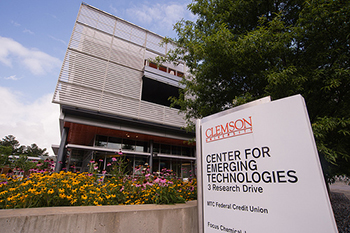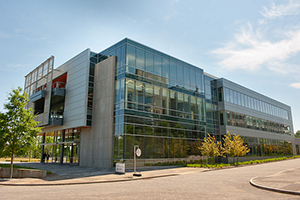Clemson Research Center Receives High LEED Honors
 GREENVILLE, S.C. — The U.S. Green Building Council (USGBC) recently awarded LEED Gold certification to the Center for Emerging Technologies at Clemson University’s International Center for Automotive Research (CET at CU-ICAR). The project also received the South Carolina American Institute of Architects (SC AIA) Honor Design in May.
GREENVILLE, S.C. — The U.S. Green Building Council (USGBC) recently awarded LEED Gold certification to the Center for Emerging Technologies at Clemson University’s International Center for Automotive Research (CET at CU-ICAR). The project also received the South Carolina American Institute of Architects (SC AIA) Honor Design in May.
The CU-ICAR campus is a 250-acre space focused on advanced-technology research. The campus provides opportunities for the university, industry and government organizations to collaborate. A master’s and Ph.D. program in automotive engineering is available at CU-ICAR as well through the College of Engineering and Science. The program conducts cutting edge research in key areas such as advanced product development strategies, sustainable mobility, intelligent manufacturing systems and advanced materials.
Five buildings are contained on the CU-ICAR campus; one received LEED Silver certification and three received LEED Gold. The Carroll A. Campbell Jr. Graduate Engineering Center, which received LEED-NC Silver, has 90,000 gross square feet and a footprint of 49,000 square feet. The innovation Place & AutoPark, which received LEED-NC Gold, contains 20,000 square feet of occupied space and 1,200 parking spaces.
The Koyo Jtekt building received LEED-CS Pilot Project Gold and the Center for Emerging Technologies received LEED Gold. The CET as a whole contains 35,000 square feet of office space on two upper levels and 25,000 square feet of high-bay space for research labs.
 The CET, located in the heart of the CU-ICAR campus, was designed by LS3P, an architecture, interior architecture and strategic visioning firm based in Greenville whose mission is to engage clients and communities and design meaningful places with transformative results. The general contractor for the project was Sherman Construction, a commercial contracting company providing services throughout South Carolina, North Carolina and Georgia.
The CET, located in the heart of the CU-ICAR campus, was designed by LS3P, an architecture, interior architecture and strategic visioning firm based in Greenville whose mission is to engage clients and communities and design meaningful places with transformative results. The general contractor for the project was Sherman Construction, a commercial contracting company providing services throughout South Carolina, North Carolina and Georgia.
Construction on the project began in June 2010 and was completed in July 2011. The total cost of the project was $6.5 million. Green building practices were utilized during the construction process, qualifying the CET for its LEED Gold certification.
Carbon dioxide monitors throughout the building monitor air quality, while adhesives, sealants, paints, coatings, composite wood products and carpets meet the standards set for low volatile organic compounds (VOCs).
Highly efficient HVAC units are used to cool and heat the building. Additional energy conservation efforts are evident in the high-efficiency bulbs used in the motion-sensitive interior light fixtures. The CET saves up to 14 percent of its energy usage with these efficient design elements.
The CU-ICAR campus also utilizes alternative transportation, including public transportation that brings individuals within a quarter mile of the CET. Shuttles bring commuters from the campus to the Clemson Area Transit System and the City of Greenville public transportation system.
Water efficiency is another key component of the CET’s sustainable design. The use of native plants reduces the need for irrigation. The facility’s restrooms use low flow fixtures and have occupancy sensors that help reduce water consumption by 40 percent.
The final element of the CET’s innovative design is its comprehensive recycling center. Designated areas for the collection, separation and storage of recyclables helps better allocate specific materials. The contracting team also kept recycling in mind during the construction process, resulting in 20 percent of the finished product stemming from recycled materials and 75 percent of the waste materials diverted from landfills and incineration facilities.
